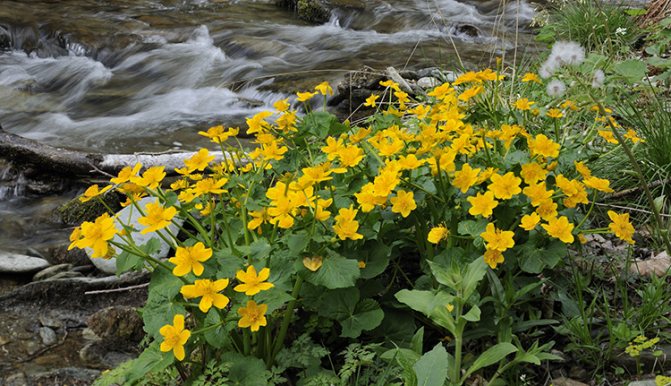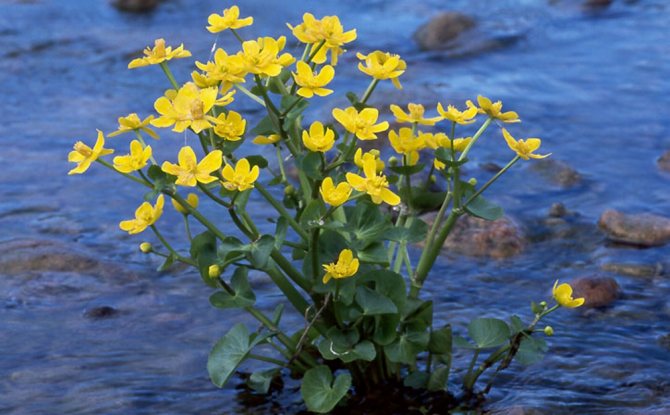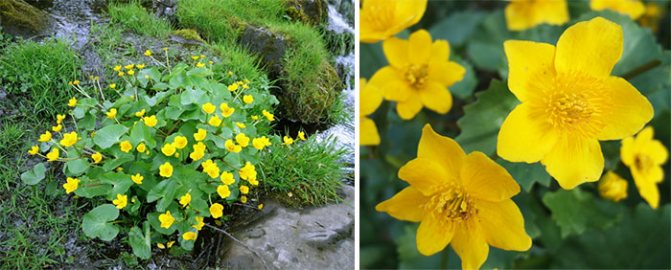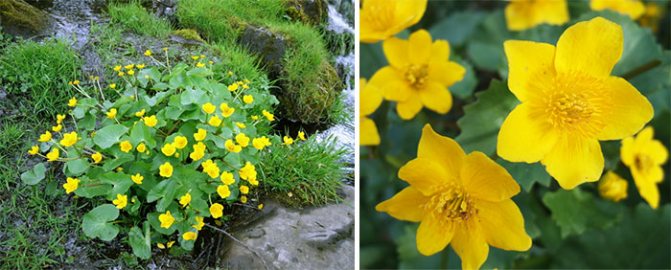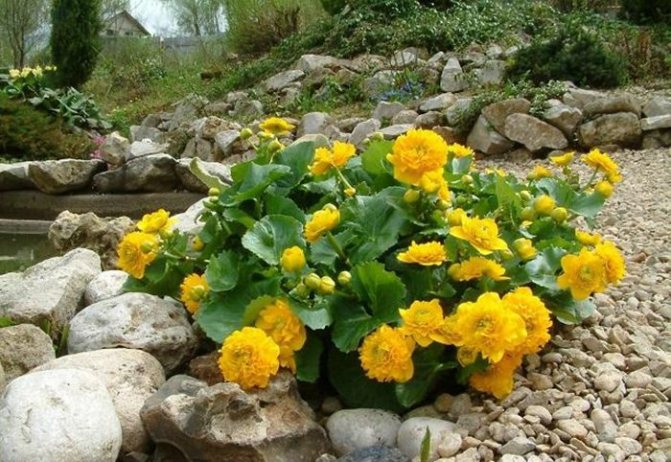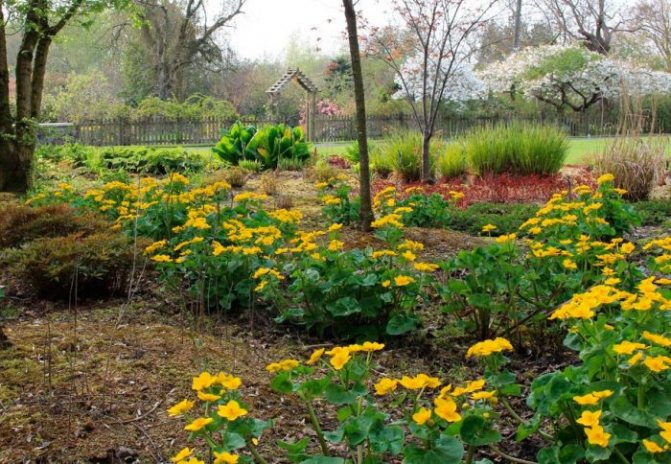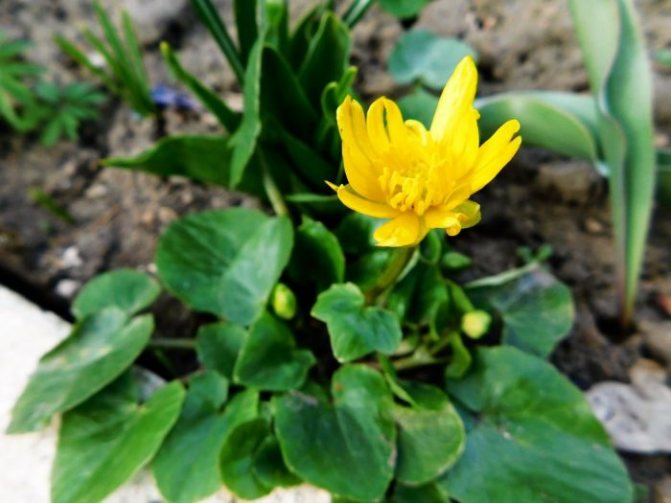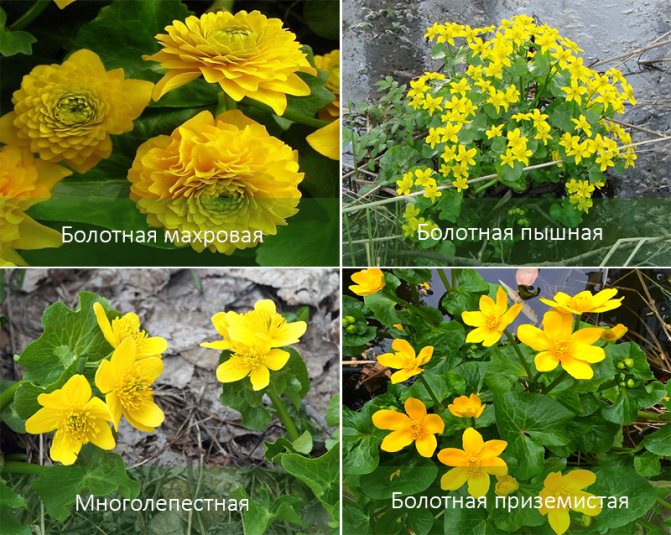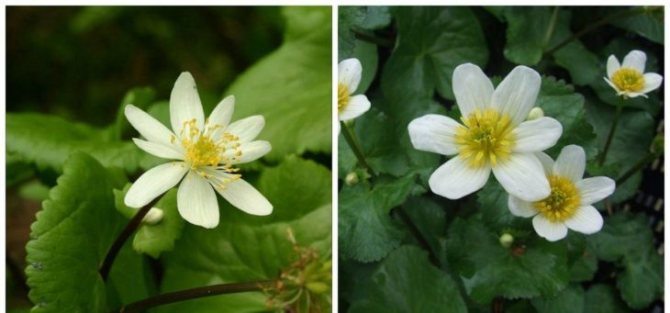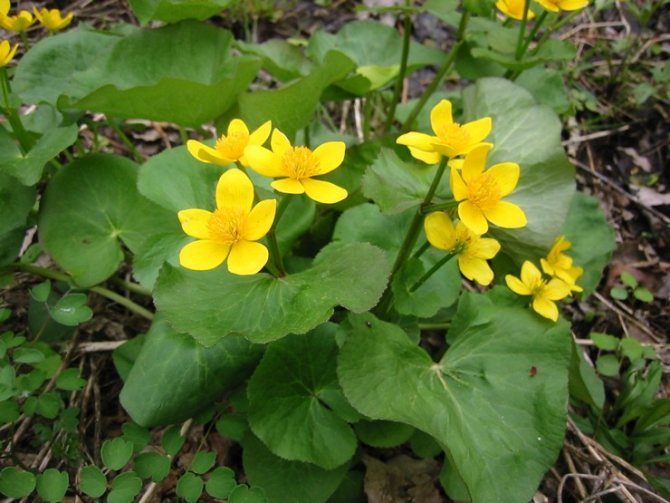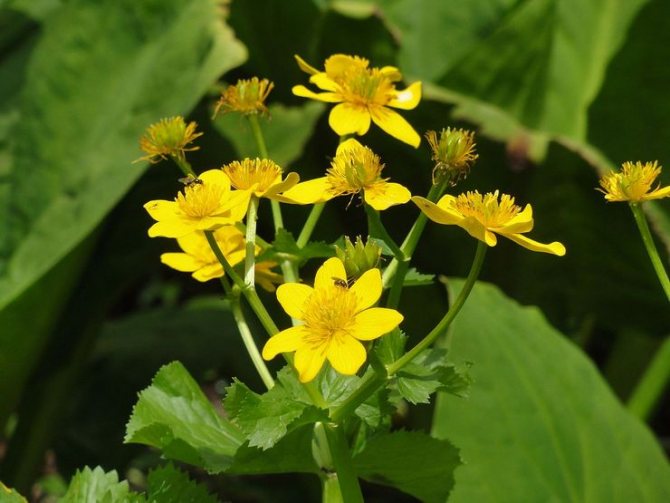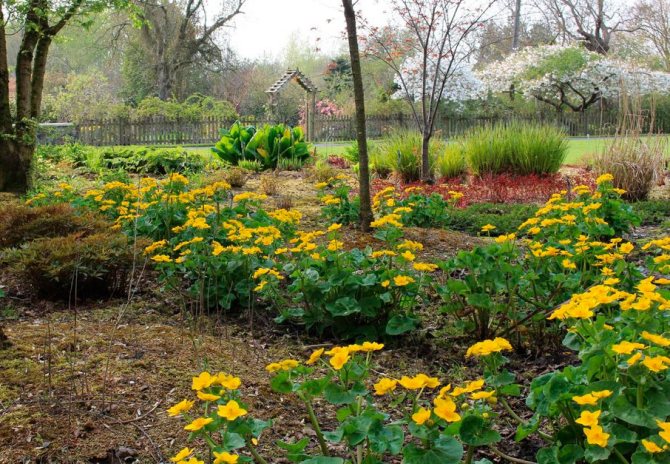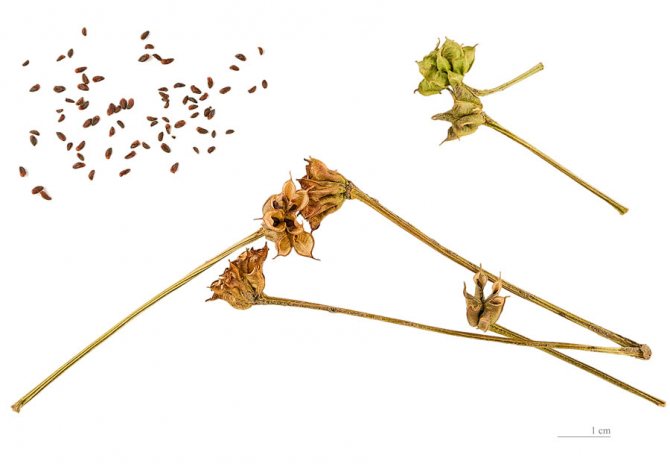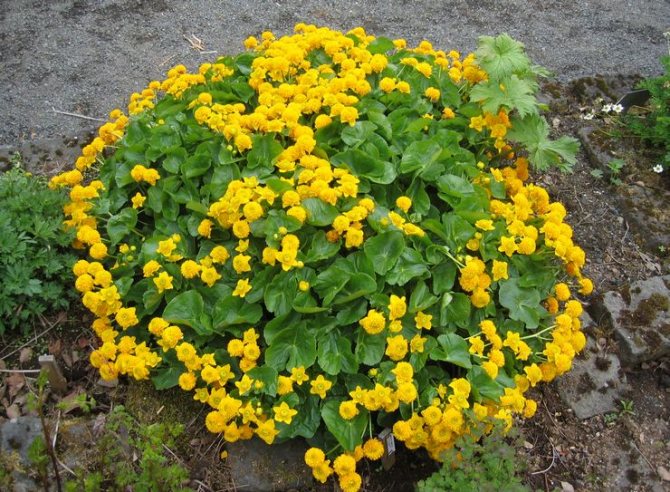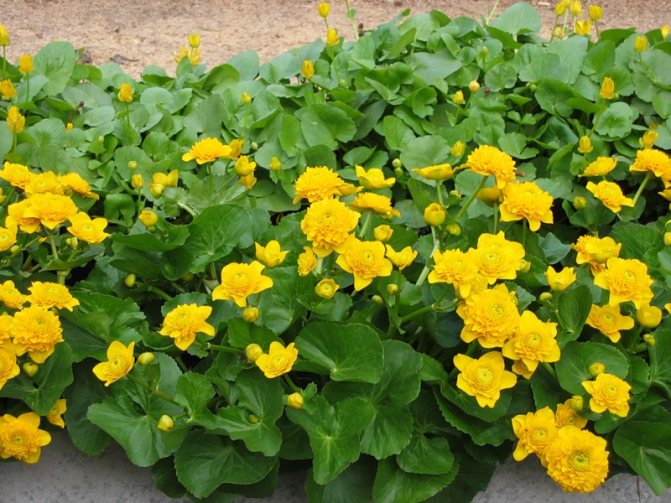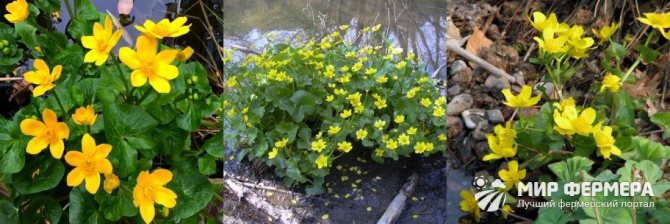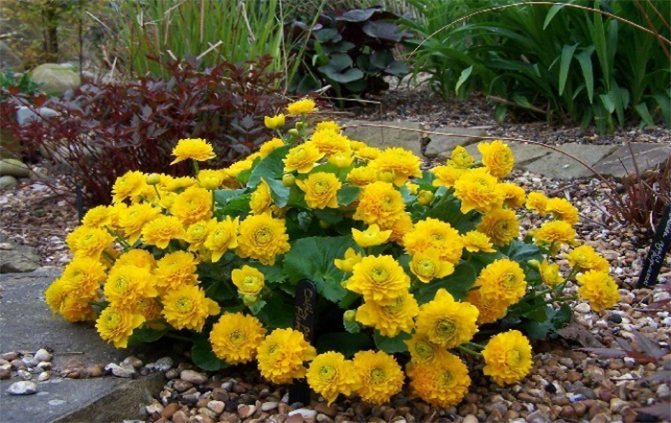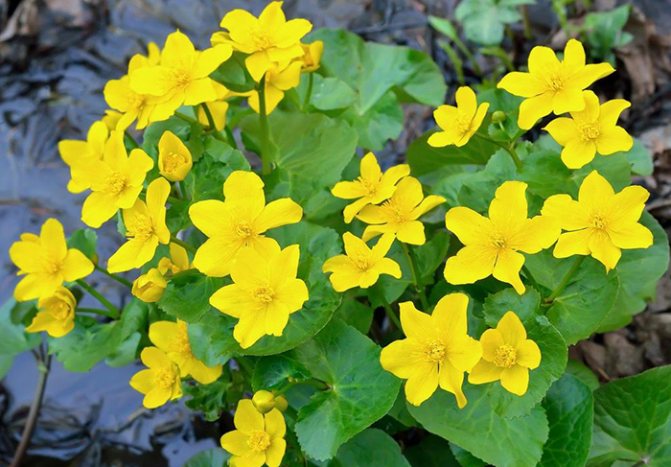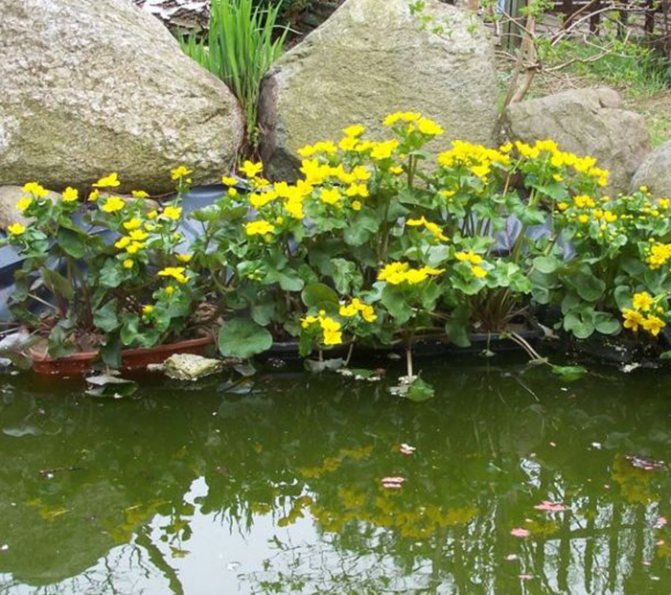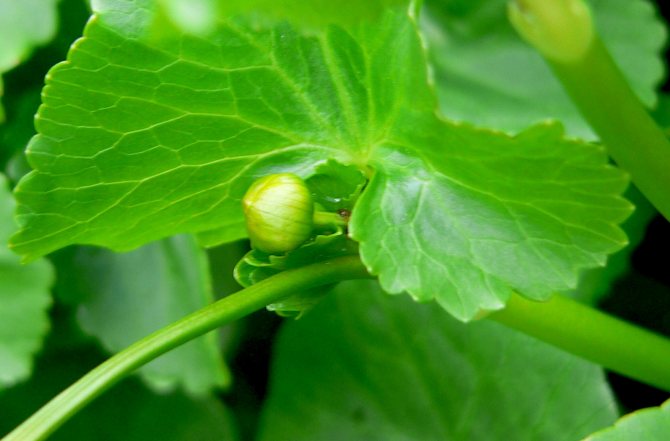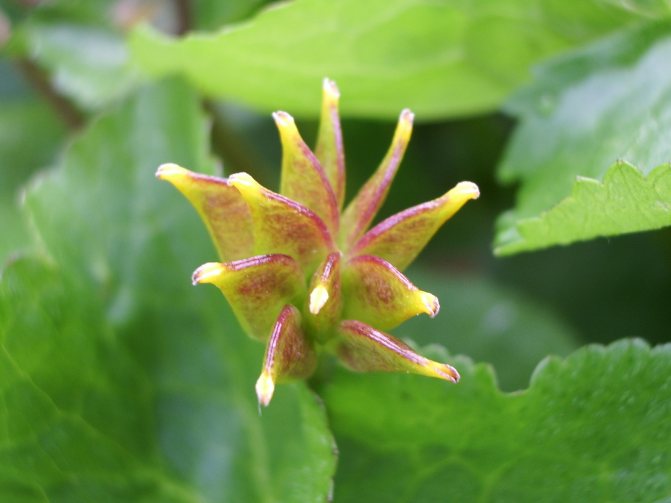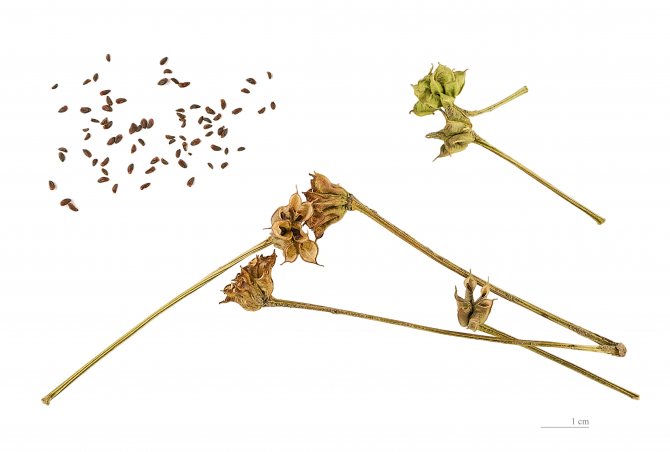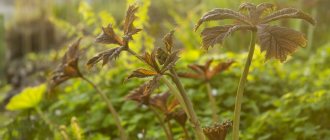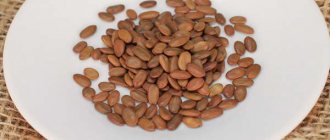In spring and early summer, the marigold flaunts its flowers, similar to those of buttercup flowers, along the banks of garden ponds and streams, forming large clumps. The flowers are cupped or dish-shaped, shiny, white, yellow or golden, with prominent yellow stamens. They are replaced by fruits joined together - leaflets. The genus includes about ten species of winter-hardy herbaceous perennials originating from temperate regions of the whole world.
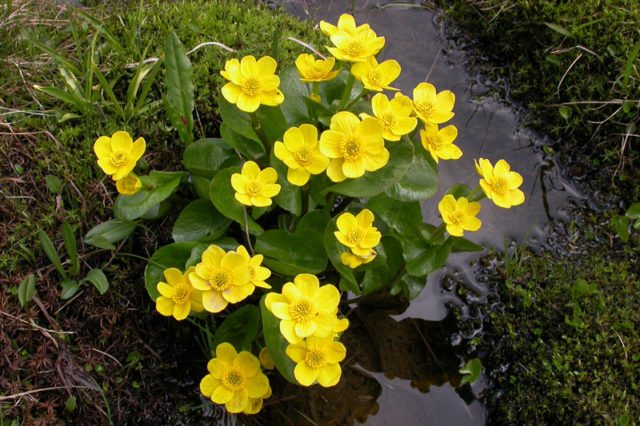
Kaluzhnitsa
Description of the plant


Marsh marigold (Cáltha palústris)
Kaluzhnitsa is a herbaceous perennial wild plant of the Buttercup family.
There are about 40 species of this species.
A characteristic feature of the marsh marigold is its height. The plant grows up to 40 cm in height when germinating in meadows and fields, and in the aquatic environment it reaches 3 m.
The stem is fleshy, leafy, glabrous, can be erect, ascending, creeping or ascending. The root system is shallow, fibrous. The plant is slightly poisonous. Marigold leaves are dark green, alternate, glabrous, heart-shaped with a jagged edge. On the back of the leaf there are pronounced red-blue veins. The size of the leaf plate is not the same in the root zone. Leaves 15 - 20 cm in diameter, on long fleshy petioles. They are smaller on the stem and have short petioles. In the upper part of the stem, near the flowers, the leaves are sessile. With a long stay under the bright direct rays of the sun, the leaves curl into a tube.
The flowers are 5 cm in diameter, predominantly yellow in color, but orange, white and golden specimens are found. Flowers are arranged singly or in groups on long peduncles from the axils of the leaves of the upper part of the stem. The flowering period is April-May, the first flowering is observed from 8-10 years of age of the plant.
In June - July, the fruit ripens - a multileaf with a small number of seeds.
The winter-hardy species tolerates the most severe frosts down to -35 ° C. Moisture-loving plants can also germinate on dry soil, subject to abundant watering.
Requirements for growing marsh marigold
Location: Marsh marigolds require open areas with sufficient moisture. In this case, they bloom most profusely. But shade-partial shade is also tolerated if this shade is created by deciduous trees and during the flowering period the site is illuminated by the sun.
The soil: since marigolds in nature are plants in damp places, they need rich, well-moisturized soil. With constant watering, it can grow in dry places.


Marsh marigold in the field. <>
Types and varieties
Due to the rich color of the foliage, the marsh marigold, even after flowering, is able to decorate any garden. Frog grass is actively cultivated, despite the fact that it looks like a wild-growing species, but with brighter flowers and longer flowering times.
Marigold Caltha leptosepala
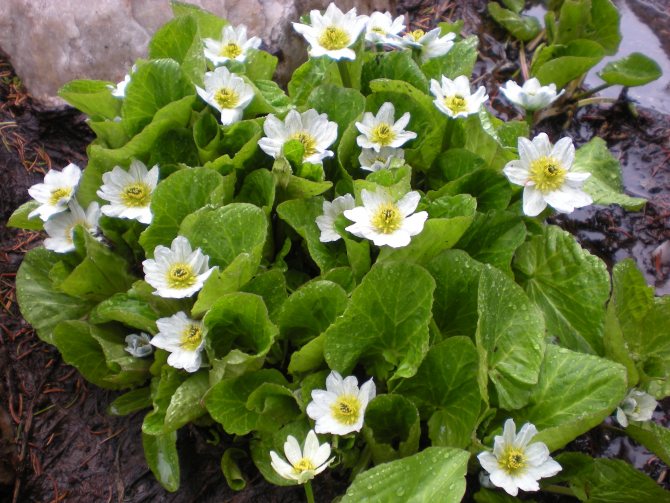

Marigold Caltha leptosepala
The two-flowered variety grows up to 35 cm in height. The stem is smooth, straight. The leaves are green, smooth, up to 10 cm long, with a solid or slightly carved edge, on petioles 5 - 25 cm long. The marigold blooms with white flowers up to 2 cm in diameter with a bright yellow core. Separate petals are elongated and oval. Flowers bloom in 1-2 pieces.at the ends of long peduncles (up to 30 cm).
Floating marigold (Caltha natans)


Floating marigold (Caltha natans)
Aquatic miniature herb with white, up to 4 cm in diameter, flowers. The leaf blade is floating, rounded with smooth edges, 3 - 4 cm in diameter. Perfect for decorating artificial ponds and reservoirs.
Membranous marigold (Caltha membranacea)
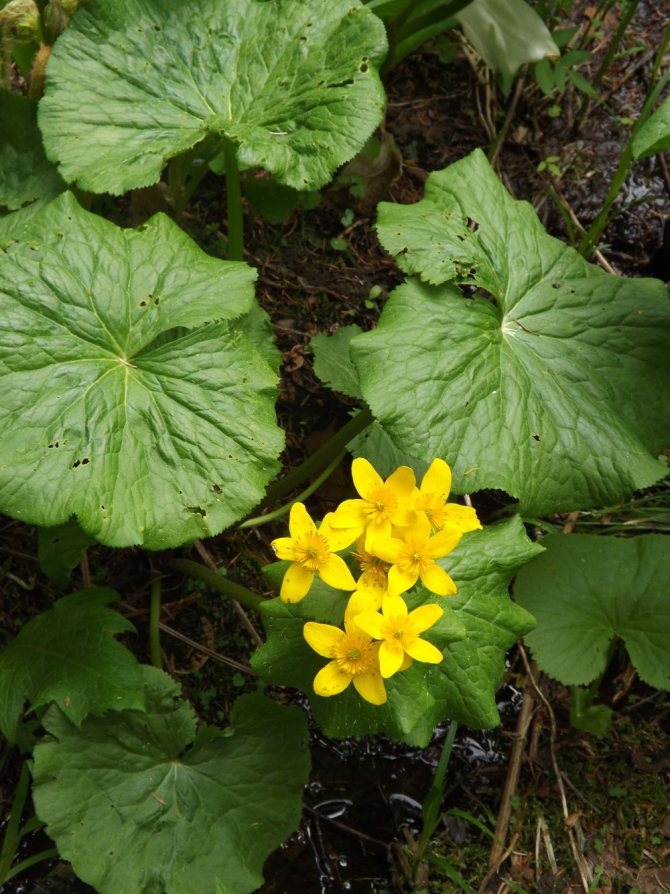

Membranous marigold (Caltha membranacea)
Densely blooming species with small bright yellow flowers. Branched stem up to 30 cm high. The leaves are large, 10 - 15 cm in size, dark green, round or kidney-shaped, on long 20 - 35 cm petioles. At the peak of flowering, up to 20 flowers can bloom at the same time on one plant.
Marsh marigold (Caltha palustris)
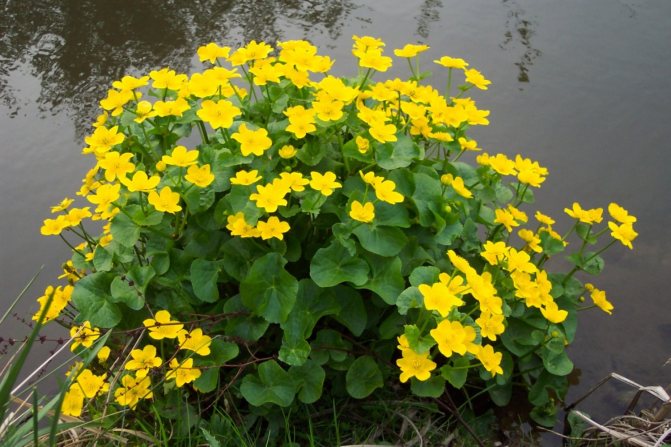

Marsh marigold (Caltha palustris)
Perennial up to 60 cm in height, with numerous fibrous, cord-like roots. Near the root system, the stem, thickened at the top, decreases and branches. The bare stem is erect or ascending. Leaves are dark green leathery, smooth and dense, with a serrated edge, cordate near the base of the stem, on long petioles. Stem sessile kidney-shaped leaves are smaller in size.
The flowers are bright yellow up to 4 - 5 cm in diameter, bloom in April-May, the flowering period is no more than 20 days, in July the fruits ripen. After flowering, the herbaceous plant grows strongly, while the leaf plates acquire a darker color. The plant is slightly poisonous.
This moisture-loving plant is found throughout the European part of Russia, Siberia, the Far East, Central Asia, mainly in swampy meadows, forests, along water bodies, along the banks of rivers and lakes.
Two-flowered marigold (Caltha biflora)
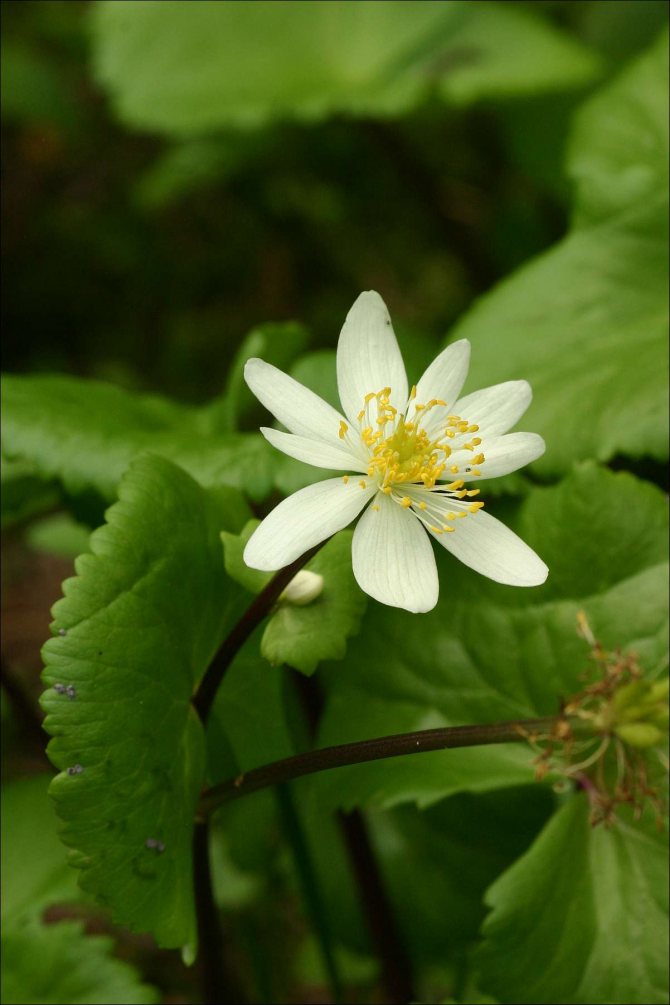

Two-flowered marigold (Caltha biflora)
Homeland - wet meadows and fields of North America. A compact bush about 8 - 10 cm in height. Green, smooth, heart-shaped leaves up to 7 cm in diameter. White flowers up to 2 cm in diameter, grow on long peduncles, towering above the plant. Flowering begins in May. The plant prefers light areas on wet soils.
Forest marigold (Caltha sylvestris)
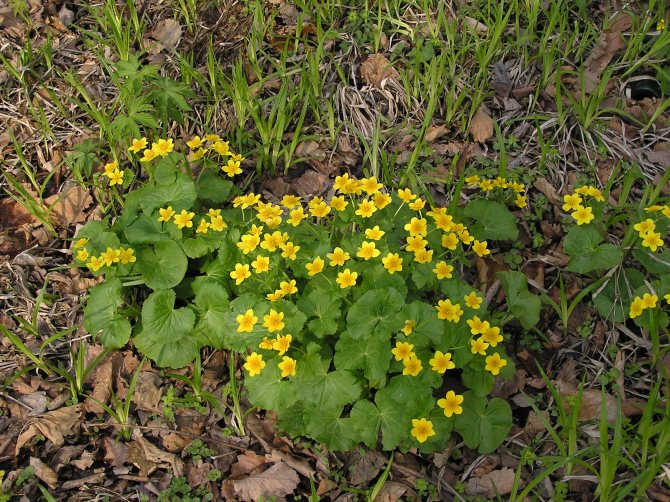

Forest marigold (Caltha sylvestris)
Perennial with an erect stem, grows up to one and a half meters. The leaves are reniform or rounded, up to 15 cm in diameter.
Forest marigold blooms with white flowers up to 3 cm in diameter, collected in groups of 5 to 15 pieces. Flowering period April-May.
Prefers sunny or semi-shady areas with moist soil. Most often found in the Far East, Korea, China.
Fistus marigold (Caltha fistulosa)
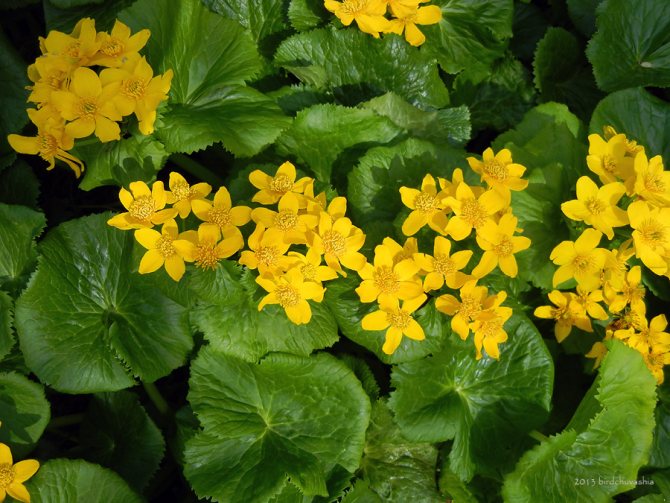

Fistus marigold (Caltha fistulosa)
The tallest herbaceous plant of all members of the marigold genus. During the flowering period, the plant does not exceed 15 - 30 cm in height. After that, it is strongly stretched and by the time the seed pod ripens, it reaches 80 - 120 centimeters.
The stem and branches are thick, hollow. The leaves are dark green, leathery, large, on long petioles. By July, the foliage grows strongly, while the leaf plates increase to 10 - 15 cm. The flowering period is May-June, the peak of flowering occurs in late May and early June. The flowers are friable, rich yellow, up to 5 - 7 cm in diameter, abundantly cover the bush. Prefers moist soil and shady areas of the garden.
White marigold (Caltha palustris var alba)
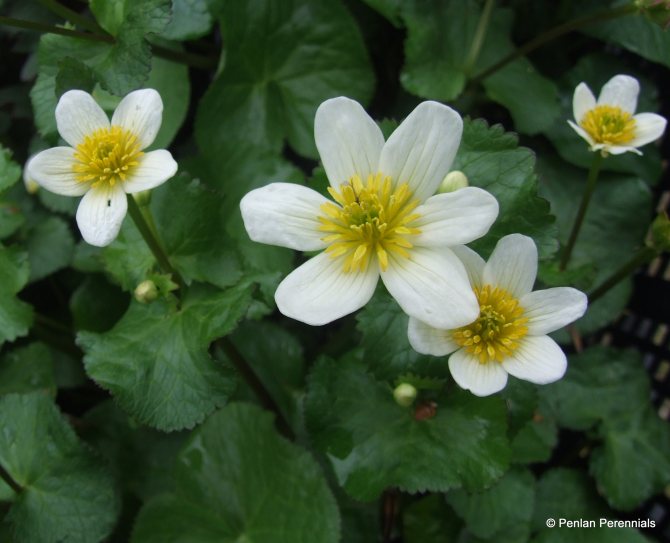

White marigold (Caltha palustris var alba)
A low, compact perennial herb, 15 - 20 cm in height. Requires at least 10 cm of area around itself. Green, smooth, shiny leaves of a cordate-rounded shape with a crenate edge. Small, solitary white flowers with separate elongated petals and a yellow core.
Terry marigold (Caltha palustris plena)


Terry marigold (Caltha palustris plena)
The compact spherical shrub reaches 30 cm in height and 30 - 45 cm in width. Multi-petalled double flowers of bright yellow color. Terry marigold begins to bloom in May. Leaves are heart-shaped - rounded, dark green. Prefers shade and partial shade with moist soil.
Lush marsh marigold (Caltha palustris subsp laeta)


Lush marsh marigold (Caltha palustris subsp laeta)
A perennial, with an ascending or ascending bare weakly branched stem, grows up to one and a half meters in height. At the base of the stem, the leaves are larger, deeply cordate, as if covering the stem. The rest of the leaves, 3 - 8 cm in size, are reniform or heart-like crenate.
After flowering, the foliage grows, the leaf plate reaches 30 centimeters. The flowers are bright yellow, loose, bloom from May to October.
Marigold (Caltha polypetala)
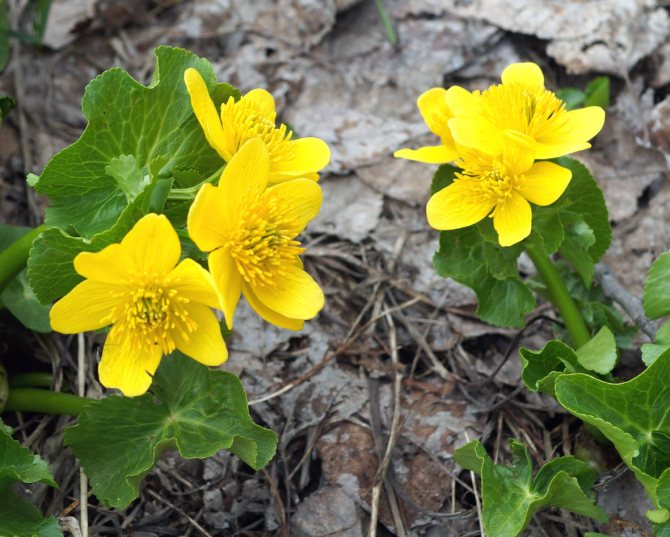

Marigold (Caltha polypetala)
The homeland of the variety is the wetlands of the mountains of the Caucasus and Asia. Due to its violent growth, the perennial takes on a spherical shape up to 15 - 30 cm in height and width. The leaves are dark green, the flowers are yellow-golden, up to 6-8 cm in diameter, the flowering period may - June.
Marsh marigold (Caltha palustris ssp procumbens)
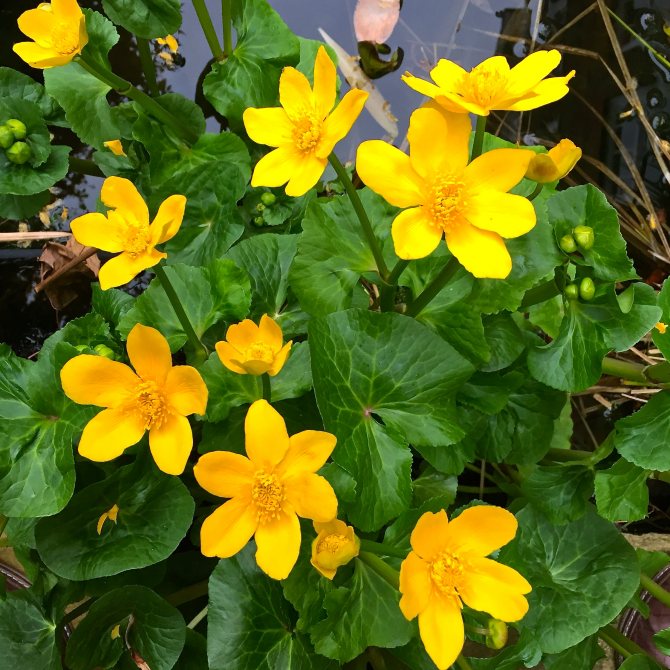

Marsh marigold (Caltha palustris ssp procumbens)
The stem is creeping or ascending, glabrous, slightly leafy, with large green cordate leaves. Flowers are yellow single, up to 5 - 8 cm in diameter.
How does marigold poisoning manifest
Before the plant starts to bloom, it is quite toxic. Therefore, during this period, you should be extremely careful when working with it.
Symptoms of marigold poisoning include:
- Stomach ache.
- Increased gas production and bloating.
- Loose stools.
- Dizziness.
- Increased urination.
- Noise in ears.
For the treatment of marigold poisoning, gastric lavage, the use of enveloping agents and saline laxatives are used.
Before flowering, the marigold plant is quite toxic.
Important. If you have a predisposition to the development of allergic reactions, then contact with marigold and the ingress of its juice on the skin and mucous membranes can provoke their appearance. Therefore, it is worth taking an antihistamine immediately.
Plant care
Kaluzhnitsa is an extremely unpretentious plant. Frost-resistant, does not need additional shelter for the winter. When planting marigold in dry soil, it is necessary to provide additional watering.
It grows equally well both in open areas and in the shade, however, in sunny areas, a brighter and more active flowering is observed. A very moisture-loving plant, with a decrease in watering, the marigold begins to bloom less often. The bush grows in 3 - 4 years, in order to preserve the decorative effect, it is necessary to plant the plants by dividing the bush.
Preparation before planting marigold
Kaluzhnitsa is not a common plant in gardens in Russia. Local gardeners have not yet fully figured out the agricultural technology of growing crops, however, if all the nuances and rules of preparation are followed before planting, it is possible to grow a beautiful and healthy plant that will delight with bright sunny flowering.
Stage 1. Selection and purchase of marigold seedlings
- First of all, you need to buy a marigold for planting. In this case, you need to give preference to garden centers or shops.
- You can buy marigold seedlings in agricultural firms that are professionally engaged in plant breeding. Here you can get competent advice on growing a plant.
- It is recommended to buy marigold varieties that have been grown in your climate, as they will be more adaptable to weather conditions. You should not purchase more thermophilic varieties of marigold, for example, arrow-shaped or New Zealand marigold.
- Be sure to check the condition of the seedlings before purchasing. They should be free of visible damage, dry parts, rot and signs of diseases and pests.
- If you buy seedlings in a container, the soil should be dry and moist.
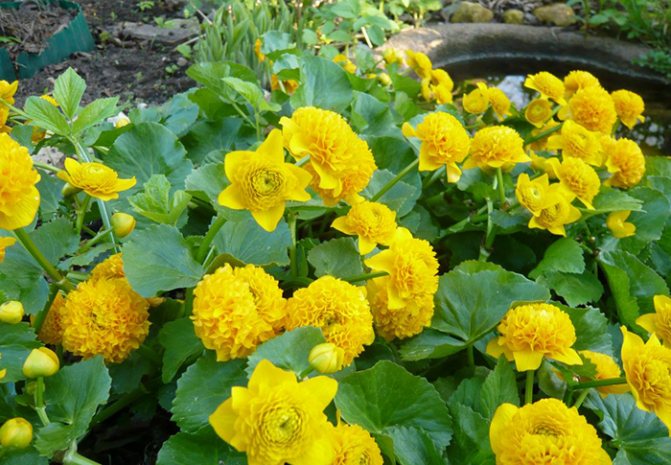

Stage 2. Choosing a place for planting marigold
- Kaluzhnitsa prefers to grow in open sunny places, although in light partial shade they also grow and bloom beautifully.
- You can plant these flowers in a small shade from the crown of trees.
- It is important to plant marigold in a well-damp area. For this, the shores of reservoirs, artificial ponds, rivers and streams are suitable. If there are swamps on your site, you can also plant flowers near them.
- You can create an artificial pond in an open area with your own hands.
- When planting marigold in dry terrain, you will have to water the soil very often.
Stage 3. Selection and preparation of soil for marigold
- Kaluzhnitsa prefers to grow on fertile and highly moist soil.
- If there is nothing suitable on your site, then you may have to create an artificial pond, instructions for improving this can be found on the Internet.
- Otherwise, you can plant marigold in the lowlands.
- Pre-dig the soil onto two bayonets of a shovel and loosen it thoroughly, then remove all weeds and roots.
Planting, growing and breeding
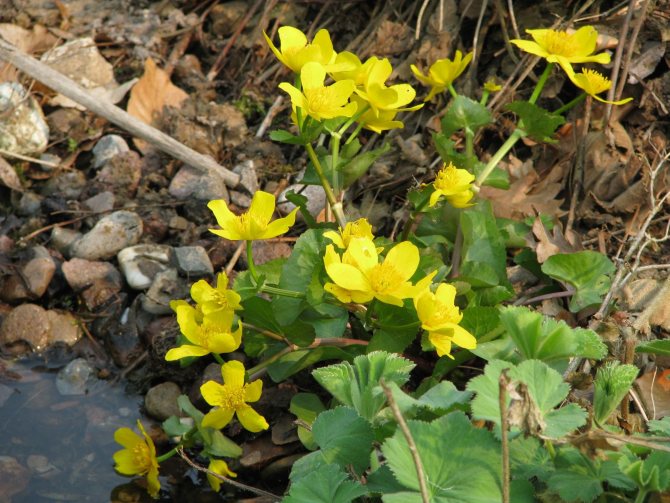

To grow a marsh marigold, special conditions are not needed, it is enough to provide the plant with good watering and not expose it to strong sunlight. In this case, the marigold will delight with beautiful early flowers and abundant green foliage. The planting of marigold should be planned so that it does not overlap with other garden crops.
Reproduction
Kaluzhnitsa is a herb for open ground, propagates by seed and vegetative method (cuttings, dividing the bush).
The division of the bush is carried out in early spring before flowering or in early autumn after flowering, but before the onset of frost. The bush is dug up, divided into parts, seated at a distance of 30 - 40 cm from each other. After transplanting, new bushes are watered and shaded until they take root in a new place. Kaluzhnitsa tolerates transplantation well.
The propagation of varieties of garden marigold by seeds occurs in spring and autumn. The seeds must be stratified: the seeds are kept at a temperature of 10 ° C for 30 days, then for 60 days at 18 - 20 ° C. Plants obtained with the seed method bloom in 2 - 3 years.
Propagation by cuttings is a faster way to get new marigold bushes. For this, the stem, together with the leaf bud, is pressed to the ground and fixed. With sufficient soil moisture, the stem will quickly take root and can be separated from the mother plant.
Plant root formation stimulants
The necessary preparations for accelerating root formation can be purchased at special gardening stores. When choosing, special attention should be paid to the composition, shelf life, method of application, storage conditions and precautions. In any case, the purchased products consist of half of chemicals. A more environmentally friendly and less costly product you can prepare yourself at home.
The willow twig stimulant is a "growth hormone" that is abundant in willow cells. To prepare the stimulant, you need to cut 4 - 6 willow twigs into pieces 3 - 5 cm long, pour them into a saucepan, pour cold water.
The smaller the pieces, the more nutrients the stimulant will contain. The saucepan is placed on low heat and cooked for 20 to 40 minutes. After that, the pan is removed from the heat, wrapped in a towel and left for 10 - 12 hours. In prepared containers, through cotton wool, fine sieve or cheesecloth, pour the resulting broth, which is stored in a cool room for no more than 30 days.
The resulting undiluted infusion is watered on transplanted plants, young seedlings, seeds before sowing.
Other stimulants are also used to improve the root formation of cuttings: honey dissolved in water, cut potato tuber, aloe juice, yeast.
Marigold planting technology
- The marigold is planted in April or September.
- If you are sowing seeds for planting, then carry out the stratification process in advance.Do not store seeds for a long time, as they lose their germination.
- If you purchased marigold seedlings in the garden center, then you need to prepare a place for planting in advance.
- First of all, it is important to take into account that this plant does not tolerate the introduction of fertilizers such as ammonium or phosphates, since these elements do not exist in the natural environment where they grow.
- When processing the site, you can add humus, since the humus substrate is ideal for planting marigold.
- Prepare planting holes in the selected area. The size of each should be slightly larger than the volume of the root system of the marigold seedling.
- Next, carefully remove the seedling from the container and place it in the planting hole, sprinkle it with soil and press it gently with your hands.
- After planting, be sure to water the young plants abundantly with water.


Application in medicine


In folk medicine, marigold is used to treat various ailments.
Chemical composition
All parts of the plant are well studied. The marigold contains alkaloids, saponins, toxic Y - lactones (protoanemonin, anemonin). All parts of the plant contain triterpenoids, steroids, carotenoids, coumarins, alkaloids. The root system includes compounds of gelleborin, inflorescences - flavonoids and quercetin.
Useful properties of marigold
Thanks to the active ingredients in folk medicine, marigold preparations are used as an anti-inflammatory, analgesic, diuretic, wound-healing, anti-febrile, antineoplastic, tonic, expectorant, anticonvulsant.
Applications of marsh marigold
Despite its poisonous qualities, the plant is actively used in alternative medicine and homeopathy.
A decoction and infusion of marigold leaves are taken for metabolic disorders, fever, anemia, cough, bronchitis, asthma, diseases of the genitourinary system, colds, jaundice and diathesis.
An infusion of herb flowers is used for ascites. Baths with the addition of a decoction of herbs are taken in the treatment of rheumatism and colds. To accelerate the healing of small wounds, ulcers and burns, apply fresh marigold leaves, pre-treated with boiling water.
How does marigold poisoning manifest
The body's reaction to marigold poisoning is headache, dizziness, ringing and tinnitus, malfunction of the digestive tract (bloating, diarrhea, colic), disruption of the normal functioning of the kidneys (frequent urination, appearance of protein in the urine, discoloration of urine).
When marigold juice gets on the skin of the body or mucous membrane, burns, burning, abscesses, and allergic reactions occur.
First aid for poisoning is gastric lavage and taking a laxative. In case of burns, the affected area of the skin is thoroughly washed with warm water, treated with an antiseptic. To reduce the allergic reaction, an antihistamine is taken.
Contraindications
It is extremely dangerous to use raw any green parts of the cut plant during flowering, as they are slightly poisonous. However, after heat treatment, the poisonous properties of the plant disappear.
Collection and storage
All parts of the plant are used in alternative medicine. The aerial part of the plant is harvested during the active flowering period. Flowers and leaves are dried, laid out on a flat surface in a well-ventilated closed or darkened room, periodically turning over, or dried in an oven at 50-60 ° C.
The root system is removed after the flowering period, closer to autumn, washed well from the ground, cut into pieces, dried and dried in the oven.
The prepared herb is transferred to linen bags or birch bark boxes. The shelf life is no more than two years.
Collection and storage
To keep the marigold for the winter as a useful raw material, you need to correctly collect the plant. The herbaceous part (flowers, leaves) of the plant is harvested during flowering. The collection should be carried out in dry weather.The collected raw materials must be dried. This can be done both in vivo and with the help of special electric dryers.
The shelf life of dried leaves and flowers is 2 years. The main thing is that the raw materials are stored in a cool but dry place. Storage containers can be different - paper bags, glass jars or wooden containers.
Important. You cannot procure marigold juice for future use.
To prepare the roots of the plant, you need to dig them up in late autumn or early spring, when the marigold is still dormant. The excavated raw material is washed, cut into thin plates (pieces) and dried. It is best to store dry roots in a wooden container or in a paper bag for no more than 2 years.
Since the plant itself is poisonous, you should not use it if you are not sure about the proportions and recipes. Proper storage is also an important aspect. The use of marigold as an ingredient for a medicine of its own production is possible only if it is stored correctly.
It is necessary to collect the marigold during the flowering of the plant.
If you notice that there are any living creatures in the prepared raw materials, or the jar with foliage and roots does not smell naturally, then the best solution would be to dispose of the workpiece.
Application in landscape design


The marigold is well suited for decorating the coastline near artificial reservoirs, as well as decorating parks on wet soils. It develops equally well both in open areas and in partial shade. When decorating man-made ponds and reservoirs, the marigold will perfectly decorate the water surface. The decorative marigold must be planted so that at the time of flowering it is not obstructed by other plants, and after flowering, lush greenery favorably emphasizes the bright flowers of plants of neighboring garden plantings.
The flowers of the marigold and its large leaves go well with the Alpine forget-me-not, lungwort, highlander, astilbe, bergenia, ostrich.
Kaluzhnitsa - photo
If you are a lover of natural landscape compositions, then the marigold will be the perfect addition to your collection. This plant will perfectly fit into any area, create a vivid picture on the banks of artificial reservoirs and ponds.
How marigold is used in cooking
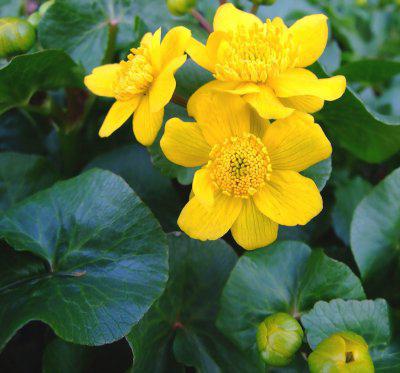

Despite the poisonousness (albeit weak), in cooking, primrose is processed into a very tasty piquant product, which is called "German capers". For this, 500 grams of unblown buds are poured with boiling water and kept for three hours. Then the water is drained and the marinade is prepared. It requires a liter of vinegar, a tablespoon of salt and sugar, pepper and bay leaf. The buds are poured with marinade and boiled. Ready capers are hermetically sealed in sterilized glass containers. They are used for dressing second courses, hodgepodge and cabbage soup.
In the Caucasus, the tops of young shoots, which have unblown flowers, are dried. And in winter they are added to roast and meat dishes. If the roots are boiled in salted water, then they can also be an excellent seasoning for fish and meat.
Mr. Dachnik recommends: useful properties of marigold and contraindications
This culture is in demand in medicine due to the content of useful microelements. It is believed that the plant promotes wound healing, destroys microbes, and stops the development of neoplasms. The following effects of marigold are also used in pharmaceuticals:
- relief of pain;
- removal of inflammation;
- reducing fever, treating symptoms of fever;
- vasoconstriction;
- removal of spasm, and, as a result, an anticonvulsant effect.
Specialists extract the healing juice from the stems and leaves, and then use it for the manufacture of various pharmaceutical and cosmetic products.
However, the independent use of the plant for medicinal purposes is prohibited.The juice contains a certain amount of poison, which can cause gastrointestinal disorders, burns of mucous membranes, and other negative consequences. Unprofessional handling with him, especially within the framework of traditional medicine, can lead to serious poisoning.
History of appearance
Species of mint - Field, Lemon Catnip, Marsh
The first publication about the plant dates back to 1753, when it came to the attention of Karl Linnaeus. However, there are still references in ancient Roman and ancient Greek written sources, where it is called "long-bloom". It is also said to have been used to treat eye diseases.
The plant received its modern name during the Kievan Rus. It grew in swampy areas (kaluzha - swamp), hence the name - kaluzhnitsa.
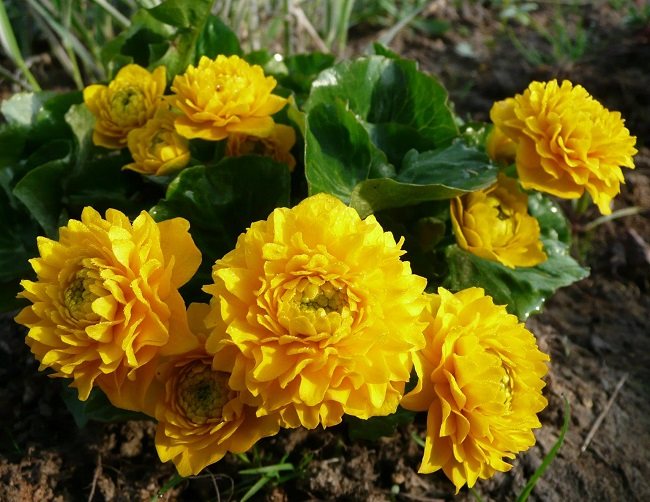

Common varieties
Care before and after flowering
For abundant flowering, the bushes need to be thinned and divided in time
This plant is so unpretentious that it practically does not require maintenance. The main activities involve the following:
- Before and during flowering, make sure that the soil is constantly moist. This is necessary so that the plant grows actively, and the flowers are bright and "juicy";
- With the beginning of flowering, fertilize the plant with a mineral agent to stimulate the active formation and splendor of the buds;
- Cut off inflorescences immediately after flowering to ensure vigorous growth and beauty of green leaves;
- Divide and replant overgrown bushes.
Medicinal and nutritional properties
Marsh marigold is poisonous. It, like many plants of the buttercup family, such as caustic buttercup, contains the substance protoanemonin. Previously, the plant was used as a medicinal, it was used for diseases of the liver, skin, colds. The saponins contained in it helped fight coughs by thinning phlegm. But the high toxicity of fresh stems and leaves forced to abandon its use in official medicine, although after cooking or drying the plant ceases to be poisonous. Now it is used in the preparation of homeopathic medicines or as an external remedy in folk medicine, which has antibacterial and wound-healing properties. The sap of the plant is used to remove warts, and a compress from the steamed leaves helps with bacterial infections of the nails.
For humans, this plant is not very poisonous. Plants such as wolf's bast and aconite are much more dangerous and, at the same time, are widely used for decorative purposes. But with self-medication, care must be taken, using fresh marigold herb only externally, and prepared - only in small doses. It is contraindicated in children, during pregnancy and lactation. Poisoning requires a large amount of toxins. Basically, marigold grass is dangerous for herbivores. In processed form it is used in cooking. So, unblown marinated buds of marigold have a spicy taste and can replace expensive capers.
Kaluzhnitsa is a beautiful primrose that blooms even before the leaves appear on the trees. She pleases us with her sunny flowers both in nature, along streams and rivers, and in the garden, where early flowering unpretentious plants are especially appreciated.
Feed value
Livestock does not eat this plant due to its toxicity. But wild animals (wild boars, moose, deer, beavers, etc.) are happy to consume all parts of the plant.
In this video, the specialist talks about the medicinal properties of Kaluzhnitsa and shows this plant.
Kaluzhnitsa is one of the brightest primroses, marking the beginning of the long-awaited spring. Due to their ease of care and resistance to frost, squat bushes with bright "sunny" flowers will adorn any artificial reservoir.
Popular varieties of terry marigold
The scientific designation of this flower comes from the Greek word, which translated into Russian means "bowl" or "basket", due to its shape.And the Russian designation of the plant comes from the old Russian "kaluzh" (this translates as "puddle" or "swamp").
- Marsh marigold - the most popular species among gardeners. Terry flowers, having a yellowish or white color.
- Fisty marigold Is a beautiful and powerful plant species. The habitat is the Japanese islands and Sakhalin. She has thick shoots that adorn the branched stems. When the plant begins to bloom, its height reaches 20 cm. And at the time when the fruits ripen, it grows up to 120 cm. Abundant flowering begins at the end of May.
- Multi-petal marigold - blooms in May or June, lives in the mountains of Asia and the Caucasus.
- Plena and Flore Plena - the two most famous and common varieties. They are attractive to gardeners with soft double flowers.
- Multiplex - the variety has large leaves and large inflorescences.
- Simple marigold - suitable for decorating areas near the coast and shallow waters.
- Membranous marigold - can grow in places with insufficient moisture. It blooms profusely, but the size of the inflorescences is smaller than that of other species.
Wild forms of marigold are less dense and compact than varietal forms of the bush. Their flowers are very similar in appearance to ranunculus and rose. It should be borne in mind when planting that the flower is a little poisonous, therefore the marsh marigold is called among the people in different ways - marsh burdock, paddling pool, frog grass, marsh violet, toad, moldokur.
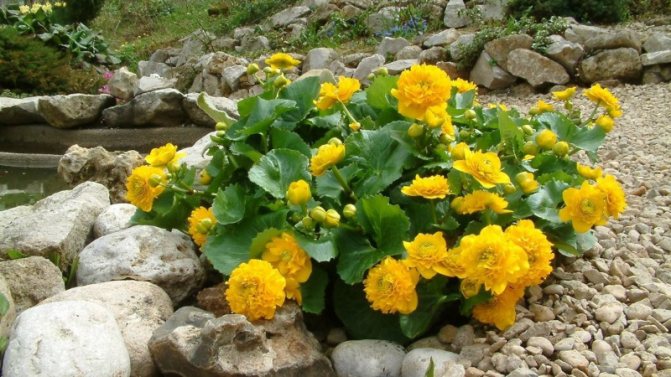

How to get a flower for reservoirs in your area
Before proceeding with planting marigold, it is necessary to choose the optimal place for it - a site with fertile and sufficiently moist soil, well lit or with a slight partial shade. The plant tolerates the winter period well even without shelter.
Landing in open ground
Kaluzhnitsa can be planted in early spring (in March) or in autumn (in September), in one of the following ways:
- Dividing the bush
... The rhizome of the dug plant is divided into parts and planted in the ground at the same distance (about 30 cm). Then the soil is watered, and the plant is darkened from the south side until it takes root, after which the shelter is removed. As a rule, the marigold tolerates the transplant well. If the plant was planted in early spring, buds appear by April, blooming in May. Planted in the fall, it manages to get stronger before the onset of cold weather and winters well. - Seeds
... Before sowing, the seeds must be kept first at a temperature of 10 ° C (1 month), and then at 18–20 ° C (2 months). In this case, flowering begins only in the second or third year after planting; - Cuttings
... In the spring, the stem of the plant must be bent to the ground and fixed with a hook, slightly digging in the shoot. The soil is then watered and kept well hydrated at all times. A new plant with its own roots is formed by the fall, and next spring it can already be planted in a permanent place.
It is best to plant marigolds in the evening, when there is no longer an active sun, and better - in cloudy weather.
Watering
In fact, being next to a pond, the marigold itself will consume the required amount of moisture.
The marigold needs constantly moist soil, especially during the period of active growth. Therefore, you need to water it every time, as soon as the soil under the bush begins to dry out. Watering tends to be more frequent during summer. This will ensure the enlargement and juiciness of the leaves of the plant, which, even after the end of flowering, does not lose its decorative effect.
Fertilizer
The marigold is fertilized using organic feeding in one of the following ways:
- in early spring, applying fertilizer to the surface with a shallow embedment;
- on the eve of winter, mulching the soil around the bush so that the spring melt water "delivered" all the nutrients to the rhizome.
Habitat and ecology
Circumboreal view.
Distributed throughout the temperate zone: in Europe (except for the southernmost part), in North America (including Alaska and Yukon), in the Caucasus and Kazakhstan, in Mongolia and Japan, in the north and west of China, as well as in the mountainous regions of the Indian subcontinent (northern India, Bhutan and Nepal).
In Russia, it grows everywhere.
It grows in slowly flowing or stagnant water around springs and along rivers and streams, in lakes, in swamps and wetlands in forests and meadows, along damp ditches. In the mountains it climbs to an altitude of 4,000 m above sea level [6].
Varieties
American [8] botanists distinguish two varieties:
- Caltha palustris var. palustris
- Caltha palustris var. radicans (T.F. Forst.) Beck,
while the Chinese [6] - five (except for Caltha palustris var. palustris):
- Caltha palustris var. umbrosa Diels
- Caltha palustris var. barthei Hance
- Caltha palustris var. sibirica Regel
- Caltha palustris var. himalaica Tamura
- Caltha palustris var. membranacea Turcz.
|
|
|
|
| ||||||
| Marsh marigold: shoot with leaf and bud (Germany), flowering plant (Poland), flower (Slovenia), fruit (Germany), dry fruits and seeds (Quebec). | ||||||||||

